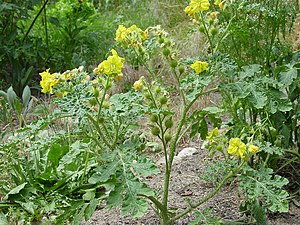Prickly nightshade
| Prickly nightshade | ||||||||||||
|---|---|---|---|---|---|---|---|---|---|---|---|---|

Prickly nightshade ( Solanum rostratum ) |
||||||||||||
| Systematics | ||||||||||||
|
||||||||||||
| Scientific name | ||||||||||||
| Solanum rostratum | ||||||||||||
| Dunal |
The prickly nightshade ( Solanum rostratum ), also called buffalo burdock , is a species of the nightshade genus ( Solanum ) within the nightshade family (Solanaceae). All parts of the plant contain poisonous Solanum alkaloids (e.g. Solanine ). It is considered the original food plant of the Colorado potato beetle .
description
Habit and leaf
Thorn nightshades are highly branched annual, herbaceous plants . Solanum rostratum forms tap roots . The above-ground parts of the plant are covered with trichomes with star-shaped heads. The stem axis is up to 1 cm thick and is covered with sharply pointed or with a broad base, yellow spines that are up to 38 mm long. The trichomes on the stem axis are stalked up to 1 mm long, but mostly directly seated.
A sympodial unit consists of two leaves, most of which are almost in pairs. The leaves are ovate to broadly ovate with rounded or truncated lobes. The leaf blade is 7 to 16 cm long, studded with spines along the main veins and hairy on both leaf sides. The leaf stalk is 1/3 to 2/3 as long as the leaf blade and is also covered with spines.
Inflorescence and flower
The inflorescences are internodal , 4 to 11 cm long and contain seven to twelve flowers . The hermaphroditic flowers have a double flower envelope . During the anthesis , the calyx is only fused with one another at the base and divided into linear lobes with a length of 6 to 10 mm, the calyx tube is bell-shaped, 1.5 to 2.5 mm long, densely hairy, bristly or sometimes with thorns occupied. The yellow corolla is pentagonal in shape, and a comprehensive, wrinkled tissue is formed between the individual petals. It has a diameter of 2.3 to 3.5 cm, the outside is downy hairy. There are two different forms of stamens in a flower . The long stamens are 1.0 to 1.4 cm long, curved in an arc and often red or purple in color. The shorter stamens are 6 to 8 mm long and yellow. The hairless ovary is closely embedded in the developing cup tube, the stylus is colored 1.0 to 1.4 cm long, slender and often purple. The stamp is not enlarged. In the distribution area, Solanum rostratum bloom all summer until autumn.
Fruits and seeds
The fruits are spherical berries with a diameter of 9 to 12 mm, which stand on slightly upright, 8 to 13 mm long stalks. The calyx, which enlarges somewhat during fruit ripening, has several constrictions and is covered with spines, which are usually somewhat longer than the spines on the stem axis. When ripe, the berry dries up and pops up to release the 40 to 80 seeds. The seeds are flat ovoid, 2.0 to 2.6 mm long, the surface is pitted, the sides are flat or wavy.
Chromosome number
The number of chromosomes is 2n = 24.
Occurrence
The original distribution area of Solanum rostratum probably extends from the area north of Mexico City over Mexico to the Great Plains of the USA . In many other areas, for example Australia or Russia , it is a neophyte . Among other things, it occurs in Germany as a neophyte.
Solanum rostratum mostly grows in open and often disturbed habitats , can adapt to many different soil types and is a " weed " on roadsides and on overgrazed grasslands . The sting nightshade occurs in Central Europe in societies of the associations Sisymbrion or Polygonum aviculare .
Systematics
Solanum rostratum is classified in the series Androceras of the Androceras section within the Leptostemonum clade of the genus nightshade ( Solanum ). The first publication of Solanum rostratum was done by Michel Félix Dunal . A synonym of Solanum rostratum Dunal is Solanum cornutum auct. non lam.
literature
- Solanaceae Source: Species description of Solanum rostratum in the Natural History Museum, London. On-line. Retrieved September 15, 2007
Individual evidence
- ↑ a b Newsletter 2009 for the Botanical Working Group in Lüchow-Dannenberg at flora-wendland.de , page 20 , accessed on April 1, 2016
- ↑ a b Erich Oberdorfer : Plant-sociological excursion flora for Germany and neighboring areas . With the collaboration of Angelika Schwabe and Theo Müller. 8th, heavily revised and expanded edition. Eugen Ulmer, Stuttgart (Hohenheim) 2001, ISBN 3-8001-3131-5 , pp. 822 .



